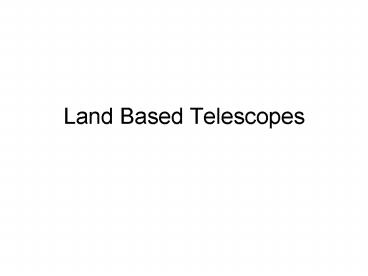Land Based Telescopes - PowerPoint PPT Presentation
1 / 31
Title:
Land Based Telescopes
Description:
Data observed by human eyes or recorded on photographs or in computers. ... Catadioptric -Uses both lenses and mirrors. First Optical Telescopes: Refractors ... – PowerPoint PPT presentation
Number of Views:214
Avg rating:3.0/5.0
Title: Land Based Telescopes
1
Land Based Telescopes
2
Telescopes "light buckets"
- Primary functions
- Gather light from a
given region of sky. - Focus light.
- Secondary functions
- Resolve detail in image
- Magnify angular size of objects.
3
Optical Telescopes
- Designed to collect wavelengths of light that are
visible to the human eye. - Data observed by human eyes or recorded on
photographs or in computers.
4
The Human Eye Shortcomings
- Eye has limited size.
- limited light gathering power.
- Eye has limited frequency response.
- only detects E-M in visible wavelengths.
- Eye distinguishes new image multiple
- times/second.
- cannot be used to accumulate light over long
period to intensify faint image. - Eye cannot store image for future reference.
- unlike photographic plate or CCD.
5
Optical Telescope Design
- Basic telescope has two parts
- Objective
- Function to gather light
- Materials lens/mirror of longer focal length
larger diameter than the eyepiece - Eyepiece
- Function to magnify image made by objective
- Material lens with a shorter focal length
than the objective
6
Optical Telescopes
- Refractors
- Focus light with refraction bend light
path in transparent medium - Use lenses
- First kind made, used by Galileo
- Reflectors
- Focus light by reflection bounce light off
a solid medium - Use mirrors
- First designed and created by Sir Isaac Newton
- Catadioptric
- -Uses both lenses and mirrors
7
First Optical TelescopesRefractors
8
Refracting Telescopes
9
The Yerkes 40 Refracting Telescope
10
Refractors Disadvantages
- Quality optics require high tolerance
- all lens surfaces must be perfect
- glass will absorb light, especially IR and UV.
- changes in orientation, temperature may flex
lenses - large size very heavy, hard to support
- Chromatic aberration
- light passes through glass
- refraction a function of wavelength
- all wavelengths focus different distances from
lens - correctable with compound lenses, expensive
11
Chromatic Aberration
- Dispersion of light through optical material
causes blue component of light passing through
lens to be focused slightly closer to lens than
red component. - Known as chromatic aberration.
12
Reflecting Telescopes Designs
13
Why build reflectors instead of refractors?
- Mirrors dont have chromatic aberration.
- Mirrors dont absorb light
(especially infrared and
UV). - Mirrors can be supported by their edge and back
lenses by ONLY their edge. - Mirrors have only one surface to be machined
correctly lenses have two.
14
Why build reflectors instead of refractors?
- 5. Telescopes made with mirrors can be compact
in design reflectors cannot. - 6. Telescopes using mirrors can have larger
objective ends (because they have bigger
mirrors), which means more light-gathering power.
15
Powers of the Telescope
- Magnifying Power
- The ability to enlarge an image.
- Light Gathering Power
- The ability to see faint objects.
- Resolving Power
- The ability to see fine details.
16
Magnification and Focal Length
17
Light-Gathering Power
- The objectives area collects light.
- The larger the area,
the
greater the light-gathering power of telescope.
Light-gathering power proportional to
(objective diameter)2.
18
Resolving Power
- Varies directly with the diameter of objective.
- Also depends on
- wavelength of light being observed and
- atmospheric seeing conditions.
19
Resolving Power Diameter and Wavelength
20
Site Selection
- Where are the best places for ground-based
observatories? - Important factors
- dark/light pollution
- good weather
- dry air
- air turbulence
21
Closer to Sea Level, More air to pass through
22
Higher Altitude, telescopes in the high mountains
23
Earth At Night
24
U.S.A. At Night (circa 1994-95)
25
Detection
- Collected light detected in many ways.
- image observed and recorded
- eye, photographic plate, CCD
- measurements
- intensity and time variability of source
- photometer
- spectrum of source
- spectrometer
26
CCD Imaging
- A charge-coupled device(CCD)
- Wafer of silicon divided into a two-dimensional
array of many tiny elements, known as pixels. - When light strikes a pixel, electric charge
builds up on device. - Charge buildup monitored electronically.
27
Radio Telescopes
- Much larger than reflecting optical telescopes
- Resemble satellite TV dishes
- Used to collect radio waves from space
- AM, FM, and TV signals interfere, so must be in a
radio protected area
28
Radio Astronomy Wavelength Advantages
- NOT dependent on time of day/night
- NOT as dependent on weather
- Use of interferometry
- Information other than visible light
- Quasars, pulsars
- Generally not absorbed traveling space
- pass through clouds of interstellar dust in our
galactic plane - Accuracy of dish shape not as hard to create or
maintain - not need to be highly polish, often light weight
29
Arecibo ObservatoryLargest Radio and Radar Dish
- 1000-ft radio dish
- Used to
- create maps of Moon, Venus, and Mars
- discover pulsars and galaxies
- measure the rotation
- rate of Mercury
- discover planetary
- systems outside of
- our solar system
30
Very Large Array(VLA) in New Mexico
27 antennas, each 25 m in diameter Effective
diameter 36 km Yields radio-image details
comparable to optical resolution
31
Interferometry
- Two or more telescopes used
- to observe same object
- at same wavelength and
- at the same time.
- Uses wave interference to
yield high resolution. - Cheaper than one (impossibly) large telescope.
- Farthest 2 telescopes act like
the end of one telescope. - Baseline
- distance between 2 farthest scopes.
- equals the relative scope size.

